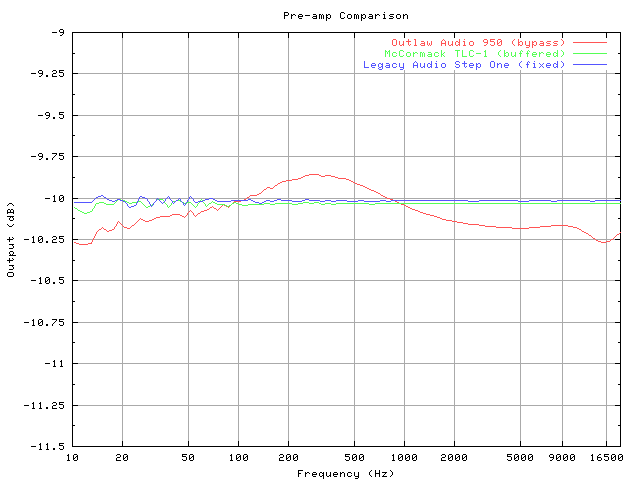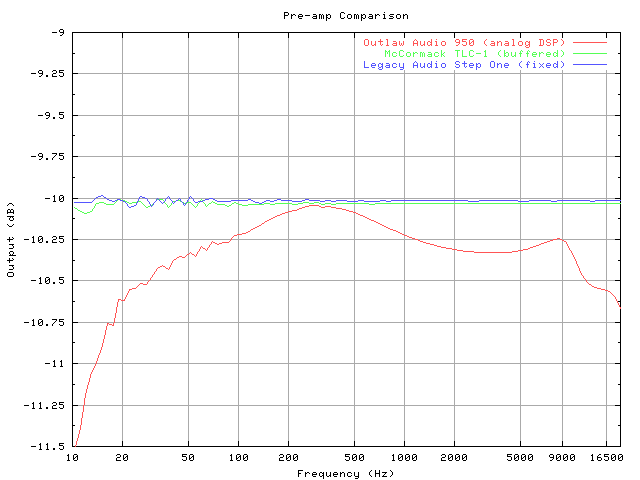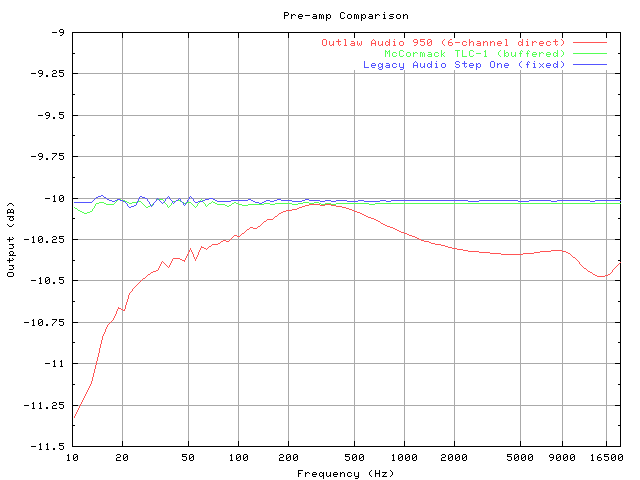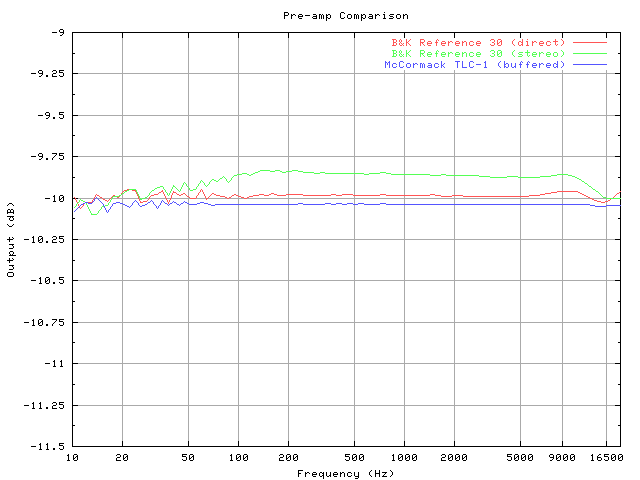
I joined the Outlaw Audio 950 Preamp/Processor waiting list on July 8th, 2002. At that time, Outlaw Audio was working through some production and performance problems with this model, mostly having to do with a few cases of "excessive" noise in the analog outputs.
I already have a competent two channel system, so the 950 will compliment it by adding Dolby Digital and DTS decoding capabilities and, along with the 755 power amp, provide surround sound capabilities for movies and DTS music.
My two channel system consists of:
| Loudspeakers: | Legacy Audio FOCUS |
| Power Amp: | McCormack DNA-1 |
| Preamp: | McCormack TLC-1 |
| Source: | Denon DVD-2800 |
| Cables: | L A T International SS-1000D and IC-200 MkII |
| Power Conditioning: | Chang Lightspeed ISO 6400 |
With this upgrade, I have added surround sound capabilities with the following components:
| Surrounds: | Legacy Audio MiST's (three) |
| 5-Channel Power Amp: | Outlaw Audio 755 |
| Processor/Preamp: | Outlaw Audio 950 |
| Cables: | L A T International IN-WALL, DI-20 MkII, and IC-100 MkII |
My 950 arrived on September 27th, 2002. This past weekend (October 7th - 8th), I finally had a few minutes to sit down and do some critical listening. At least 80% of the time, my system is used for listening to music rather than playing movies, so two channel analog performance is important to me. My hope has been that the analog performance of the 950 would be close enough to that of my McCormack TLC-1 that I could retire the McCormack. This would significantly simplify my cabling and give me the ability to adjust the volume using a remote!
Small differences in volume level can skew the results of any component comparison, so before I could get started with serious listening, I had to establish a standard volume level. To accomplish this, I adjusted the volume on the TLC-1 to a comfortable level and played the pink noise track (track 15) on the Stereophile Test CD 2. On a Radio Shack SPL meter, this registered at about 88 dB.
Using the same cables, I then connected the analog outputs of the DVD player to the DVD inputs on the 950, and the front channel outputs of the 950 to the DNA-1 power amp. I adjusted the volume level on the 950 in analog bypass mode to match the SPL reading that I took previously from the TLC-1. The display on the 950 reported that the volume was set to -17 dB.
For the audition, I chose track two on Norah Jones's CD, Come Away with Me. This track has a natural sounding lead vocal and clean acoustic bass. The imaging on a properly configured system can be startling!
On the McCormack, the acoustic bass on this track is tight and dynamic but not excessively so. Norah Jones' voice has a natural presence and smooth airiness. The stereo image is both wide and deep and there is plenty of air around Norah's voice.
On the Outlaw, the acoustic bass sounds a bit more lively and dynamic. The stereo image is just as wide as on the McCormack but lacks some of the depth. Also, the airiness that I noted during the McCormack listening session seems to be rolled off a bit on the Outlaw. Overall, the sound is pleasing, but noticeably different from the McCormack.
Next, I listened to the same track using Denon as a transport and using the DAC in the Outlaw. After compensating again for the difference in volume levels (had to move up to -12 dB on the Outlaw), I noted that the top end seems to be even more rolled off. The acoustic bass sounds noticeably warmer but less dynamic than the presentation on the McCormack. Also, the depth of the stereo image is significantly reduced compared to the analog outputs feeding either the McCormack or the Outlaw.
I wanted to understand why the analog sections of the McCormack and the Outlaw sound so different, but to do that would require measurements. I purchased a download copy of TrueRTA for this task. Following the procedures in the TrueRTA documentation, I calibrated the sound card in my PC for flat response. Using the same cables that I would be using for the measurements, I ran a "Quick Sweep" frequency plot several times to verify that the response was flat.
I connected the output of my sound card to the CD inputs on the McCormack and connected the buffered outputs of the McCormack to the Line-In on the sound card. I then set the McCormack volume to the maximum level ("unity gain" on the McCormack), and ran a "Quick Sweep" response plot.
For the Outlaw, I restored the system the the factory default settings, with all channel calibrations set to 0 dB and the volume set to 0 dB. I then connected the output of the sound card to the DVD inputs and the Front outputs to the sound card Line-In. I used the analog bypass option (as I did during my listening) so that the analog signal does not pass through the A-to-D converters. The resulting frequency response plot for the Outlaw, the McCormack, and the fixed output of my Legacy Audio Step One environmental processor (included for reference) is shown below.

The difference between the frequency response of McCormack and the Outlaw seems be consistent with what I heard. The extra "warmth" in the acoustic bass is due to the rise in response centered around 300 Hz, and the treble roll-off is due to the dip that is centered around 15 kHz.
According to Outlaw's published specifications, the frequency response of the direct inputs should be 10 Hz to 20 kHz, +0 / -0.2 dB. The response that I measured was not far outside of this: +0.15 / -0.275 dB. Although these numbers don't look far off, the impact on the sound is not difficult to hear.
While I had the Outlaw on the bench, I measured the frequency response of the Analog-DSP and 6-Channel Direct inputs. For the 6-Channel measurement, I had to set the volume level to -3 dB. The plots are shown below.


I am particularly disappointed by the response from the 6-Channel Direct inputs. I have not done any listening through these inputs yet, but I would have expected them to provide the best response since they logically should be designed with the shortest signal path to the outputs. After seeing these graphs, I need to double check my configuration to verify that I'm not somehow passing the signal through the DSP.
If this is in fact the best response of the direct inputs, it is significantly outside of Outlaw's published specifications of 10 Hz to 20 kHz +0 / -0.2 dB.
This past weekend, I had time to do some more extended listening to the 6-Channel Direct inputs. I would have preferred to have listened to them before seeing the plots so that there would be no chance of my impression of the sound being skewed the plots. However, the sound from these inputs (after compensating for volume level) was clearly inferior to that of the normal 2 channel inputs in bypass mode. As anticipated by the plots, the high frequencies sounded noticeably more rolled off than the two channel inputs in bypass mode.
I was fortunate to be able to borrow a B&K Reference 30 preamp/processor ($2,800 list) from a local audio dealer. Like the Outlaw, the Reference 30's stereo inputs have a "DSP" and a "Direct" mode. Unlike the Outlaw, the measured frequency response of the B&K's 6-Channel Direct inputs is identical to that of the stereo inputs in "Direct" mode. Here's a plot that compares the "Direct" and "Stereo" modes (like "Bypass" and "DSP" on the Outlaw) with my old McCormack preamp:

During 2 channel analog listening, it not difficult to hear the difference between my old McCormack and the "stereo" mode, which passes the analog signals through the B&K's internal A-to-D and D-to-A converters. However, it was virtually impossible to hear the difference between the McCormack and the B&K's "Direct" mode analog inputs!
During movie playback, I heard even more substantial differences between the performance of the Outlaw Audio 950 and the B&K. The most significant differences are in how the two units deal with "missing" speakers in the 7.1 array. On the Outlaw, when I play chapters from Fellowship of the Ring, the dialog is soft and at times difficult to hear on the Outlaw with the "virtual" center channel. On the B&K, dialog was every bit as clear with the "virtual" center channel as with a real one.
Another big difference was with how the two units direct LFE signals to the "Large" speakers. LFE bass on the B&K sounds powerfull, but not excessive or overbearing. Comparitively, LFE through the Outlaw sounds week and at times, absent. When I played the THX Audio tests on Disney's Atlantis DVD, the LFE signal measured 11 dB lower than the fronts on the 950 compared with only 2 dB lower on B&K. I also noticed that the "virtual" center channel measured 2 dB louder than the fronts on the 950 compared with 5 dB louder on the B&K. These measurements explain what I heard.
Since it will be a while before I am able to add a center channel and subwoofer to my system, the processors's ability to create convincing "virtual" versions of these is very important. The Outlaw Audio 950 is not able to do this nearly as well as the B&K.
I'm going to work with the excellent support staff at Outlaw to find out if the response of my unit is out of spec. or significantly worse than other 950's. I'm also planning to work through a local Rotel dealer to evaluate (and measure) a 1066 preamp/processor for comparison.
The folks at Outlaw were not able to provide me with an explanation for the response curve that I was measuring and the sound that I was hearing from the 6-Channel Direct inputs. They said that these do not pass through the A-to-D converters, but the response curve suggests otherwise, and in any case I was not satisfied with the sound in my system for my particular use. The Outlaw team was very accomodating in helping me to return my 950 for a full refund, including shipping (I still had to pay for return shipping, which seems fair).
Unfortunately, I was unable to audition a Rotel processor in my system. Neither of the two Atlanta area Rotel dealers would allow me to bring a unit home over a weekend! Since I was very pleased with the sound and performance of the B&K Reference 30, I decided to purchase it from Ed at Sound and Cinema and retire my old TLC-1.
I have finally added a sub to this system! After considering a number of products, I decided to purchase the Legacy Audio Point One, which matches the FOCUS loudspeakers that I'm using for fronts. So far, I have been very pleased with the performance of the Point One, although I'm still playing with positioning. Unfortunately, my room is 19' x 21', which is fairly close to square, and dealing with standing waves at 55 Hz can be a challenge when you have two 15" drivers and six active 12" drivers and nearly 1.5 kw of power pushing them. :-)
I have decided to upgrade my B&K Reference 30 to the processing capabilities of the Reference 50. I won't have the balanced inputs and outputs or the RJ-45 expansion port, but adding THX Ultra 2 processing, DTS-ES, Dolby ProLogic II, and DTS Neo:6 for less than $550 including shipping both ways is just too good of a deal to pass up. This investment protection is one of the reasons that I chose the B&K over the Outlaw and Rotel. My upgraded processor should be back by September 2nd (about two weeks round-trip!), so I'll post an update after I have had some time to listen and take some measurements.
If you have any questions or comments, feel free to contact me via email.
January 6th, 2003.